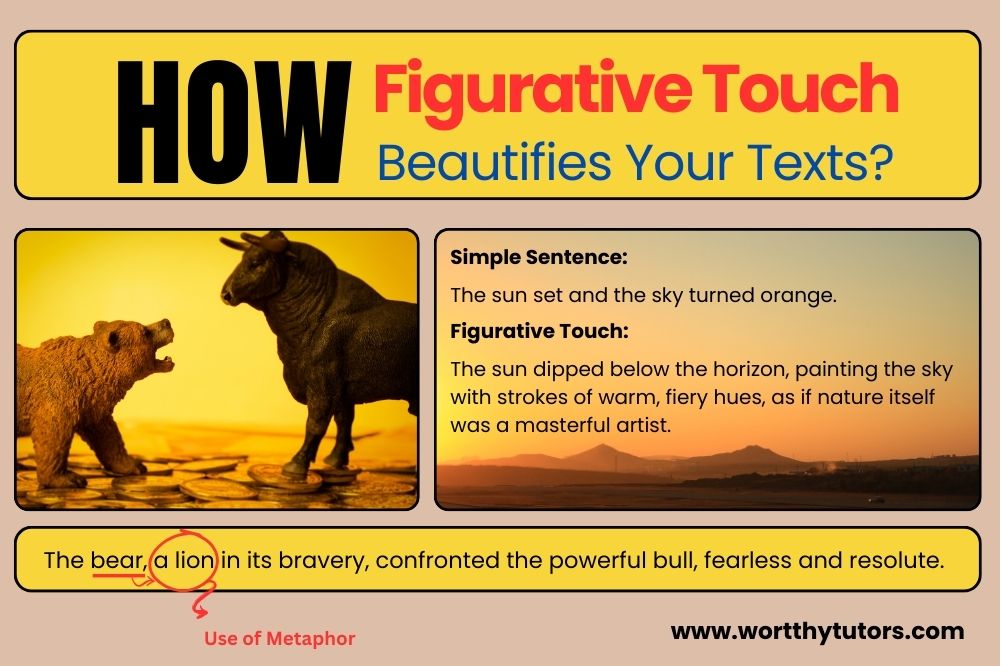
Figurative language involves expressions that depart from the literal meanings of words to create a more vivid or imaginative impact. It includes techniques like metaphors, similes, personification, and hyperbole. Using figurative language in content writing enhances creativity, engages readers, and conveys complex ideas more effectively. It adds depth and emotion to the text, making it more memorable and enjoyable.
The use of figurative language dates back to ancient times, with notable thinkers like Aristotle, Homer, Quintilian, and Horace exploring its functions. Figurative language involves expressions that go beyond literal meanings, relying on context for interpretation. It includes figures of speech such as similes, metaphors, and personification.
Commonly Used Figures of speech.
- Simile: Simile compares two things using words like “like” or “as.” For example, saying “His heart is as hard as rock” illustrates a strong comparison.
- Metaphor: Metaphors, on the other hand, imply a comparison between two things without using connecting words. Saying “Time is money” emphasizes the value of time.
- Oxymoron: oxymoron combines contradictory words to create new meanings, like calling someone the “wisest fool.”
- Hyperbole: Hyperbole involves deliberate exaggeration for emphasis, such as saying a hilltop touches the sky.
- Personification: Personification attributes human traits to non-human entities, adding beauty to the text.
- Irony: Irony conveys a meaning opposite to what is stated, like calling an untrustworthy character “honest.”
- Idiom: Idioms are common short phrases that do not carry surface meaning but they have some with implied meanings.
- Synecdoche: Synecdoche uses a part to represent the whole, like calling someone the “Shakespeare of India.”
- Metonymy: Metonymy substitutes a related concept for the original, such as using “pen” for an author.
- Alliteration: Alliteration repeats initial consonant sounds for a musical effect, while assonance repeats vowel sounds.
- Apostrophe: Apostrophe addresses an inanimate object or abstract idea directly.
- Pun: Puns create humor by using a word with multiple meanings, and allusions reference other texts, authors, or objects.
- Symbolism: Symbolism uses words to represent concepts, like a red rose symbolizing love.
- Epigram: Epigrams are short, witty sayings expressing antithetical ideas, providing surprise and insight.
Examples of Simple Sentences vs. Figurative Sentences
In below examples, the first sentence is in simple wording and same is repeated with touch of figurative language.
- Simple: The sun set and the sky turned orange.
- Figurative: The sun dipped below the horizon, painting the sky with strokes of warm, fiery hues, as if nature itself was a masterful artist.
- Simple: The river flowed gently through the valley, reflecting the blue sky above.
- Figurative: The river meandered through the valley like a silver ribbon, mirroring the endless expanse of the azure sky overhead.
- Simple: The old tree stood tall in the middle of the meadow, its branches reaching towards the sun.
- Figurative: The ancient tree stood sentinel in the heart of the meadow, its boughs outstretched like fingers reaching for the golden touch of the sun
- Simple: The children played happily in the park, their laughter filling the air.
- Figurative: The children danced through the park like joyful sprites, their laughter a symphony that echoed through the open spaces.
- Simple: The city skyline sparkled with lights as night fell.
- Figurative: As night descended, the city skyline became a glittering tapestry of lights, like a constellation of dreams woven into the fabric of the urban landscape.
- Simple: The mountain peak was covered in snow, glistening in the sunlight.
- Figurative: The mountain peak wore a majestic cloak of snow, a radiant white crown shimmering under the sun’s affectionate gaze.
Use of Figurative Language in Scene Description
Below is a paragraph that describes the scenic description of a day passing out. First paragraph is in simple wording while same is repeated with touch of figurative language. You may understand that how words change the style of the writing to make it more attractive for the readers.
Non-Figurative Language:
The city woke up as the sun rose, casting a gentle light on the buildings. As the day went on, the sun went down, painting the sky with warm colors like orange and pink. This signaled that night was coming. Cars moved on the streets, and people who had worked during the day went home. The air got cooler, and the city gradually became quiet at night, with the last bit of sunlight giving way to darkness.
Figurative Language:
With the first light of day, the city stirred from its slumber, bathed in the gentle hues of dawn’s palette. As the sun embarked on its descent, it painted the sky in a breathtaking symphony of colors—warm oranges, passionate pinks, and the subtle purples of twilight. The buildings, touched by the sun’s farewell, stood like silent spectators to nature’s grand performance. Cars flowed through the streets like streams of shimmering light, carrying people who had devoted their day to work and aspirations. As the sun dipped below the skyline, the city embraced the gathering dusk, a canvas now adorned with the soft glow of streetlights and the twinkle of distant stars. In this tranquil transition, people, weary from the day’s endeavors, sought refuge in the comforting embrace of their homes, ready to rest and rejuvenate for the adventures of a new day.